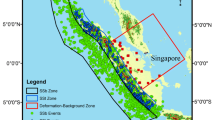Abstract
Taiyuan is a city in Shanxi Province, China, and possesses serious seismic hazard. In this study, we constructed a time-dependent seismic hazard model for Taiyuan and the surrounding area based on several major-earthquake seismogenic structures for which historical and paleoseismic event data were available. With the time-dependent model, we calculated the distribution of peak ground acceleration with 10% probability of exceedance in the next 50 years in Taiyuan and the surrounding area, and compared the results with those calculated using the time-independent model. The results showed that the entire area around Taiyuan has a higher seismic hazard with the time-dependent model than that with the time-independent model. The Jiaocheng and Hengshan faults have much higher seismic hazard. Applying the model only to Taiyuan showed that the city has higher seismic hazard with the time-dependent model than that with the time-independent model. In particular, in the western part of Taiyuan, the seismic hazard is quite high because of the proximity of the area to the Jiaocheng Fault.





Similar content being viewed by others
References
Aki K (1968) Seismic displacement near a fault. J Geophys Res 73(16):5359–5376
Campbell KW, Bozorgnia Y (2008) NGA ground motion model for the geometric mean horizontal component of PGA, PGV, PGD and 5% damped linear elastic response spectra for periods ranging from 0.01 to 10 s. Earthquake Spectra 24(1):139–171
Chen PS, Li BK, Bai TX (1998) Prediction of peak horizontal acceleration in the light of tectonic ambient shear stress field. Chinese J Geophys (in Chinese) 41(4):502–517
Cornell CA (1968) Engineering seismic risk analysis. Bull Seismol Soc Am 58(5):1583–1606
Ding R, Ren JJ, Zhang SM (2009) Late quaternary activity and paleoearthquakes along the Nanyukou segment of the northern piedmont fault of the Wutai Mountain. Earthquake Research in China 25(1):41–53 (in Chinese)
Esteva L (1970) Seismic risk and seismic design decisions. In: Hansen RJ (ed) Seismic design for nuclear power plants. Massachusetts Institute of Technology Press, Cambridge, MA, pp. 142–182
Field EH, Arrowsmith RJ, Biasi GP et al (2014) Uniform California Earthquake Rupture Forecast, version 3 (UCERF3)—the time-independent model. Bull Seismol Soc Am 104(3):1122–1180
Guo H, Jiang WL, Xie XS (2012) Analysis of Holocene faulting phenomena revealed in the three trenches along the northern and central Jiaocheng fault, Shanxi. Seismology and Geology 34(1):76–92 (in Chinese)
Gutenberg B, Richter CF (1944) Frequency of earthquakes in California. Bull Seismol Soc Am 34(4):185–188
Hu YX (1999) Seismic safety evaluation technology tutorials. Seismological Press, Beijing (in Chinese)
Jiang WL, Xie XS, Wang HZ et al (2003) Holocene palaeoseismic activities along the northern piedmont fault of Hengshan Mountain, Datong Basin, Shanxi Province. Earthquake Research in China 19(1):8–19 (in Chinese)
Jiang WL, Deng QD, XW X (2004) Surface rupture zone of the 1303 Hongtong M=8 earthquake, Shanxi Province. Acta Seismol Sin 26(4):355–362 (in Chinese)
Li XJ (2013) Adjustment of seismic ground motion parameters considering site effects in seismic zonation map. Chinese Journal of Geotechnical Engineering (in Chinese) 35(Supp. 2):21–29
McGuire RK (1976) Fortran computer program for seismic risk analysis. USGS Open-File Report 76–67
Nishenko SP, Buland R (1987) A generic recurrence interval distribution for earthquake forecasting. [J]Bull Seismol Soc Am 77(4):1382–1399
Pan H, Gao MT, Xie FR (2013) The earthquake activity model and seismicity parameters in the new seismic hazard map of China. Technology for Earthquake Disaster Prevention (in Chinese) 8(1):11–23
Schnabel PB, Seed HB (1973) Accelerations in rock for earthquakes in the western United States. Bull Seismol Soc Am 63(2):501–516
Wells DL, Coppersmith KJ (1994) New empirical relationships among magnitude, rupture length, rupture width, rupture area, and surface displacement. Bull Seismol Soc Am 84(4):974–1002
Working group on California earthquake probabilities (1988) Probabilities of large earthquakes occurring in California on the San Andreas fault, USGS Open-File Report 88, 398
Working group on California earthquake probabilities (1990) Probabilities of large earthquakes in the San Francisco Bay region. USGS Survey circular, California, p. 1053
Working Group on California Earthquake Probabilities (1996) Seismic hazards in Southern California: probable earthquakes, 1994 to 2024. Bull Seismol Soc Am 85(2):379–439
Working group on California earthquake probabilities (1999) Earthquake probabilities in the San Francisco Bay region, 2000–2030—a summary of findings, USGS Open-File Report, 99, 517
Working group on California earthquake probabilities (2003) Earthquake probabilities in the San Francisco Bay region, 2002–2031, USGS Open-File Report, 03, 214
Working group on California Earthquake Probabilities (2008) The Uniform California Earthquake Rupture Forecast, version 2 (UCERF 2), USGS Open File Report 2007, 1437
Xie XS, Jiang WL, Sun CB et al (2008) Comparison study on holocene paleoseismic activities among multi-trenches along the Jiaocheng Fault zone, Shanxi. Seismology and Geology 30(2):412–430 (in Chinese)
Xu YR (2012) A study on the late Quaternary faulting of the Huoshan piedmont fault zone in the Central Shanxi faulted basin belt. Institute of Geology, China Earthquake Administration, Beijing
Yu YX, Li SY, Xiao L (2013) Development of ground motion attenuation relations for the new seismic hazard map of China. Technology for Earthquake Disaster Prevention (in Chinese) 8(1):24–33
Zhang PZ, Deng QD, Zhang GM et al (2003) Active tectonic blocks and strong earthquakes in continental China. Science in China (Series D) 46(Supplement):13–24
Zhou BG, Chen GX, Gao ZW et al (2013) The technical highlights in identifying the potential seismic sources for the update of national seismic zoning map of China. Technology for Earthquake Disaster Prevention (in Chinese) 8(2):113–124
Acknowledgements
The time-independent seismic hazard model was obtained from the Compiling Committee of the Seismic Zoning Map in China. We thank them for providing the area source model, seismicity model, GMPE model, and site condition model data.
Author information
Authors and Affiliations
Corresponding author
Additional information
Sponsored by: International partnership program of Chinese Academy of Sciences (131551KYSB20160002); Fundermental Research Specific Fund (DQJB16B19).
Rights and permissions
About this article
Cite this article
Li, C., Xu, W., Wu, J. et al. Time-dependent probabilistic seismic hazard assessment for Taiyuan, Shanxi Province, China, and the surrounding area. J Seismol 21, 749–757 (2017). https://doi.org/10.1007/s10950-016-9633-1
Received:
Accepted:
Published:
Issue Date:
DOI: https://doi.org/10.1007/s10950-016-9633-1




